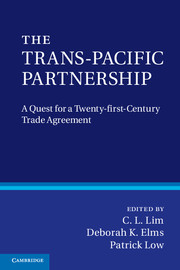Book contents
- Frontmatter
- Contents
- List of Figures and Tables
- Contributors
- Preface
- Acknowledgements
- Disclaimer
- Glossary
- Part I Introduction
- Part II The past: origins of the TPP Agreement
- Part III The present: twenty-first century elements and obstacles
- Part IV The future: high-quality meets regional and global realities
- 15 Achieving a Free Trade Area of the Asia-Pacific
- 16 APEC and the TPP
- 17 Coping with multiple uncertainties
- 18 The TPP
- 19 The TPP in a multilateral world
- Part V The TPP negotiations: the quest for quality
- Index
- References
16 - APEC and the TPP
are they mutually reinforcing?
Published online by Cambridge University Press: 05 November 2012
- Frontmatter
- Contents
- List of Figures and Tables
- Contributors
- Preface
- Acknowledgements
- Disclaimer
- Glossary
- Part I Introduction
- Part II The past: origins of the TPP Agreement
- Part III The present: twenty-first century elements and obstacles
- Part IV The future: high-quality meets regional and global realities
- 15 Achieving a Free Trade Area of the Asia-Pacific
- 16 APEC and the TPP
- 17 Coping with multiple uncertainties
- 18 The TPP
- 19 The TPP in a multilateral world
- Part V The TPP negotiations: the quest for quality
- Index
- References
Summary
Introduction
The Trans-Pacific Strategic Economic Partnership Agreement (TPSEP), between Brunei Darussalam, Chile, New Zealand and Singapore, came into force in 2006. This Agreement, which is also known as the P4, was the first preferential trade agreement (PTA) to be comprised of more than two members from both sides of the Pacific Rim.
Article 20.6 of the P4 allows “any APEC Economy or other State” to accede to the Agreement. Within this context, Australia, Peru and the United States launched negotiations in 2008 with the P4 members, while Malaysia and Viet Nam joined fully in the negotiations in 2010. In the course of these negotiations, the approach to extend the P4 switched to negotiating a new PTA, as all parties agreed that existing PTAs in force among any of them would coexist with the new agreement. This process, referred as the Trans-Pacific Partnership (TPP) negotiations, attempts to achieve a wider PTA in the Pacific Rim.
This process is an attempt to create the largest PTA in the Asia-Pacific region, and is one of the potential paths towards a future Free Trade Area of the Asia-Pacific (FTAAP). At the present time, all the TPP negotiating parties are APEC members, which if successful, will bring a new PTA with a greater scope in comparison with the P4. The TPP negotiations are already fuelling debate in the public arena due to its multiple economic and political implications at bilateral, regional and multilateral levels. Indeed, APEC is not exempted from this discussion, as its relevance in this new context has been examined from different perspectives.
- Type
- Chapter
- Information
- The Trans-Pacific PartnershipA Quest for a Twenty-first Century Trade Agreement, pp. 242 - 259Publisher: Cambridge University PressPrint publication year: 2012



